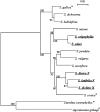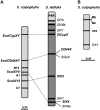Independent origin of sex chromosomes in two species of the genus Silene
- PMID: 18558658
- PMCID: PMC2429867
- DOI: 10.1534/genetics.107.085670
Independent origin of sex chromosomes in two species of the genus Silene
Abstract
Here we introduce a new model species, Silene colpophylla, that could facilitate research of sex chromosome evolution and sex-determining systems. This species is related to the well-established dioecious plant model Silene latifolia. Our results show that S. colpophylla is, similarly to S. latifolia, a male heterogametic species, but its sex chromosomes have evolved from a different pair of autosomes than in S. latifolia. The results of our phylogenetic study and mapping of homologs of S. latifolia X-linked genes indicate that the sex determination system in S. colpophylla evolved independently from that in S. latifolia. We assert that this model species pair will make it possible to study two independent patterns of sex chromosome evolution in related species.
Figures



Similar articles
-
Evolution of sex determination systems with heterogametic males and females in silene.Evolution. 2013 Dec;67(12):3669-77. doi: 10.1111/evo.12223. Epub 2013 Sep 2. Evolution. 2013. PMID: 24299418
-
Evolution of sex determination and heterogamety changes in section Otites of the genus Silene.Sci Rep. 2019 Jan 31;9(1):1045. doi: 10.1038/s41598-018-37412-x. Sci Rep. 2019. PMID: 30705300 Free PMC article.
-
Silene latifolia: the classical model to study heteromorphic sex chromosomes.Cytogenet Genome Res. 2010 Jul;129(1-3):250-62. doi: 10.1159/000314285. Epub 2010 Jun 10. Cytogenet Genome Res. 2010. PMID: 20551610 Review.
-
Multiple nuclear gene phylogenetic analysis of the evolution of dioecy and sex chromosomes in the genus Silene.PLoS One. 2011;6(8):e21915. doi: 10.1371/journal.pone.0021915. Epub 2011 Aug 10. PLoS One. 2011. PMID: 21853022 Free PMC article.
-
The genomics of plant sex chromosomes.Plant Sci. 2015 Jul;236:126-35. doi: 10.1016/j.plantsci.2015.03.019. Epub 2015 Apr 2. Plant Sci. 2015. PMID: 26025526 Review.
Cited by
-
Disentangling the effects of mating systems and mutation rates on cytoplasmic [correction of cytoplamic] diversity in gynodioecious Silene nutans and dioecious Silene otites.Heredity (Edinb). 2013 Aug;111(2):157-64. doi: 10.1038/hdy.2013.32. Epub 2013 Apr 17. Heredity (Edinb). 2013. PMID: 23591518 Free PMC article.
-
Evolution of Young Sex Chromosomes in Two Dioecious Sister Plant Species with Distinct Sex Determination Systems.Genome Biol Evol. 2019 Feb 1;11(2):350-361. doi: 10.1093/gbe/evz001. Genome Biol Evol. 2019. PMID: 30649306 Free PMC article.
-
Tempo of Degeneration Across Independently Evolved Nonrecombining Regions.Mol Biol Evol. 2022 Apr 11;39(4):msac060. doi: 10.1093/molbev/msac060. Mol Biol Evol. 2022. PMID: 35325190 Free PMC article.
-
Identification of sex-linked SNP markers using RAD sequencing suggests ZW/ZZ sex determination in Pistacia vera L.BMC Genomics. 2015 Feb 18;16(1):98. doi: 10.1186/s12864-015-1326-6. BMC Genomics. 2015. PMID: 25765114 Free PMC article.
-
A White Campion (Silene latifolia) floral expressed sequence tag (EST) library: annotation, EST-SSR characterization, transferability, and utility for comparative mapping.BMC Genomics. 2009 May 25;10:243. doi: 10.1186/1471-2164-10-243. BMC Genomics. 2009. PMID: 19467153 Free PMC article.
References
-
- Bratteler, M., C. Lexer and A. Widmer, 2006. A genetic linkage map of Silene vulgaris based on AFLP markers. Genome 49 320–327. - PubMed
-
- Charlesworth, B., and D. Charlesworth, 1978. Model for evolution of dioecy and gynodioecy. Am. Nat. 112 975–997.
-
- Charlesworth, D., and F. R. Ganders, 1979. Population genetics of gynodioecy with cytoplasmic-genic male sterility. Heredity 43 213–218.
Publication types
MeSH terms
LinkOut - more resources
Full Text Sources

